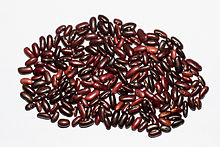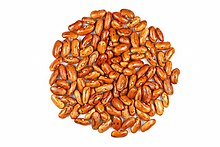Kidney bean

Thekidney beanis a variety of the commonbean(Phaseolus vulgaris) named for its resemblance to ahuman kidney.
| Nutritional value per 100 g (3.5 oz) | |
|---|---|
| Energy | 532 kJ (127 kcal) |
22.8 g | |
| Sugars | 0.3 g |
| Dietary fiber | 7.4 g |
0.50 g | |
8.7 g | |
| Vitamins | Quantity %DV† |
| Thiamine (B1) | 13% 0.16 mg |
| Riboflavin (B2) | 5% 0.06 mg |
| Niacin (B3) | 4% 0.58 mg |
| Pantothenic acid (B5) | 4% 0.22 mg |
| Vitamin B6 | 7% 0.12 mg |
| Folate (B9) | 33% 130 μg |
| Vitamin C | 1% 1.2 mg |
| Vitamin E | 0% 0.03 mg |
| Vitamin K | 7% 8.4 μg |
| Minerals | Quantity %DV† |
| Calcium | 2% 28 mg |
| Copper | 27% 0.24 mg |
| Iron | 16% 2.9 mg |
| Magnesium | 11% 45 mg |
| Phosphorus | 11% 142 mg |
| Potassium | 13% 403 mg |
| Sodium | 0% 2 mg |
| Zinc | 10% 1.07 mg |
| Other constituents | Quantity |
| Water | 67 g |
| †Percentages estimated usingUS recommendationsfor adults,[1]except for potassium, which is estimated based on expert recommendation fromthe National Academies.[2] | |
Classification[edit]
There are different classifications of kidney beans, such as:
- Red kidney bean (also known as: common kidney bean, rajma in India, surkh (red) lobia in Pakistan).
- Light speckled kidney bean (and long shape light speckled kidney bean).
- Red speckled kidney bean (and long shape light speckled kidney bean).
- White kidney bean (also known as cannellini in Italy and the UK, lobia in India, or safaid (white) lobia in Pakistan).
Nutrition[edit]
Kidney beans, cooked by boiling, are 67% water, 23%carbohydrates,9%protein,and contain negligiblefat.In a 100-gram reference amount, cooked kidney beans provide 532 kJ (127 kcal) offood energy,and are a rich source (20% or more of theDaily Value,DV) of protein,folate(33% DV),iron(22% DV), andphosphorus(20% DV), with moderate amounts (10–19% DV) ofthiamine,copper,magnesium,andzinc(11–14% DV).
Dishes[edit]


Red kidney beans are commonly used inchili con carneand are used in the cuisine ofIndia,where the beans are known asrajmaandPakistanwhere they are called surkh lobia. Red kidney beans are used in southernLouisianafor the classic MondayCreoledish ofred beans and rice.The smaller, darker red beans are also used, particularly in Louisiana families with a recent Caribbean heritage. In Jamaica, they are referred to as red peas. Small kidney beans used inLa Rioja, Spain,are calledcaparrones.In theNetherlandsandIndonesia,kidney beans are usually served as a soup calledbrenebon.[3]In theLevant,a common dish consisting of kidney bean stew usually served with rice is known asfasoulia.To make bean paste, kidney beans are generally prepared from dried beans and boiled until they are soft, at which point the dark red beans are pulverized into a dry paste.
Toxicity[edit]
Red kidney beans contain relatively high amounts ofphytohemagglutinin,and thus are more toxic than most other bean varieties if not pre-soaked and subsequently heated to the boiling point for at least 10 minutes. The USFood and Drug Administrationrecommends boiling for 30 minutes to ensure they reach a sufficient temperature long enough to completely destroy the toxin.[4]Cooking at the lower temperature of 80 °C (176 °F), such as in aslow cooker,is insufficient to denature the toxin and has been reported to cause food poisoning.[4]Canned red kidney beans, though, are safe to eat straight from the can, as they are cooked prior to being shipped. As few as five raw beans or a single undercooked kidney bean can cause severe nausea, diarrhea, vomiting, and abdominal pains.[5][6][7]
Cookbook[edit]
 Bean Chiliat the Wikibooks Cookbook subproject
Bean Chiliat the Wikibooks Cookbook subproject Chili (Vegan)at the Wikibooks Cookbook subproject
Chili (Vegan)at the Wikibooks Cookbook subproject Easy Chiliat the Wikibooks Cookbook subproject
Easy Chiliat the Wikibooks Cookbook subproject Minestraat the Wikibooks Cookbook subproject
Minestraat the Wikibooks Cookbook subproject Pandora's Feastat the Wikibooks Cookbook subproject
Pandora's Feastat the Wikibooks Cookbook subproject Rice an' Peasat the Wikibooks Cookbook subproject
Rice an' Peasat the Wikibooks Cookbook subproject Three Bean Confetti Saladat the Wikibooks Cookbook subproject
Three Bean Confetti Saladat the Wikibooks Cookbook subproject Vegetarian Bean Soupat the Wikibooks Cookbook subproject
Vegetarian Bean Soupat the Wikibooks Cookbook subproject
References[edit]
- ^United States Food and Drug Administration(2024)."Daily Value on the Nutrition and Supplement Facts Labels".FDA.Archivedfrom the original on 2024-03-27.Retrieved2024-03-28.
- ^National Academies of Sciences, Engineering, and Medicine; Health and Medicine Division; Food and Nutrition Board; Committee to Review the Dietary Reference Intakes for Sodium and Potassium (2019). Oria, Maria; Harrison, Meghan; Stallings, Virginia A. (eds.).Dietary Reference Intakes for Sodium and Potassium.The National Academies Collection: Reports funded by National Institutes of Health. Washington, DC: National Academies Press (US).ISBN978-0-309-48834-1.PMID30844154.Archivedfrom the original on 2024-05-09.Retrieved2024-06-21.
- ^"Recipe: Soup Brenebon".FAO.
- ^ab"Bad Bug Book (2012)"(PDF).Foodborne Pathogenic Microorganisms and Natural Toxins Handbook: Phytohaemagglutinin.Food and Drug Administration. 2012.Retrieved26 December2013.
Consumers should boil the beans for at least 30 minutes to ensure that the product reaches sufficient temperature
- ^"Be Careful With Red Kidney Beans in The Slow Cooker".Mother Earth News.
- ^"Cooking safely with slow cookers and crock pots".foodsmart.govt.nz.Archived fromthe originalon 2016-01-02.Retrieved2015-03-06.
- ^"Raw Kidney Beans".Home Food Preservation (Penn State Extension).
